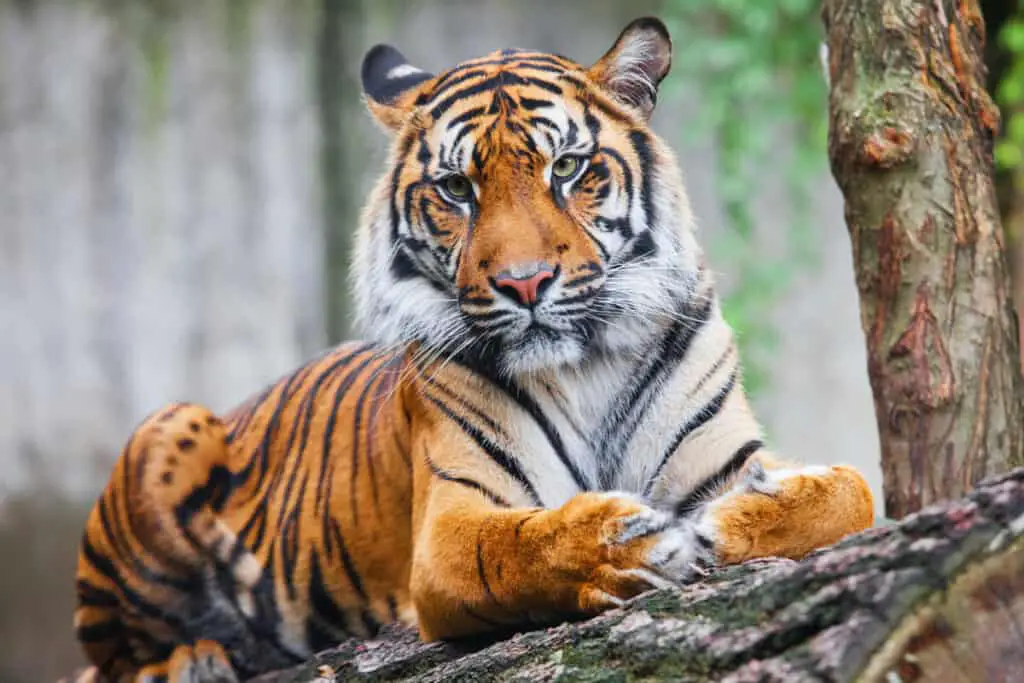The Sumatran tiger is one of the most endangered species in the world. These majestic creatures are native to Indonesia and are known for their striking orange fur with black stripes, which sets them apart from other tiger subspecies.
Sadly, there are less than 400 Sumatran tigers left in the wild due to habitat loss, poaching, and human-wildlife conflict. Despite conservation efforts being made by organizations around the globe, these tigers still face an uphill battle to survive.
In this article, we will explore more about the Sumatran tiger’s lifestyle, habitat, threats they face and what can be done to help protect them.

Appearance And Characteristics
The Sumatran tiger is the smallest subspecies of tiger and is only found on the Indonesian island of Sumatra. It has a distinctive appearance, with dark-orange fur and black stripes that are closer together than those of other tigers. The pattern of the stripes also differs between individuals, making each one unique.
Behavioral patterns of Sumatran tigers include being solitary animals, except during mating season when they will seek out their partner. Breeding habits involve both male and female tigers marking their territory with urine to attract mates.
After a gestation period of around 100 days, females give birth to litters of up to four cubs in secluded dens away from predators. These cubs stay with their mother for two years before venturing off on their own.
Overall, the Sumatran tiger’s physical characteristics and behavioral patterns make it an impressive predator in its natural habitat.
Habitat And Distribution
The striking appearance and characteristics of the Sumatran tiger make it one of the most admired animals in Asia. Its bright orange coat with black stripes, muscular body, and fierce expression symbolize strength, power, and courage. However, these features are not only for show; they help the animal survive in its natural habitat.
Living mainly on the Indonesian island of Sumatra, this big cat is critically endangered due to habitat loss and poaching. As a result, conservation efforts have been put in place to protect this magnificent species from extinction. The importance of preserving the Sumatran tiger goes beyond just saving a beautiful creature from disappearing forever. It has an ecological significance crucial for maintaining biodiversity in Southeast Asia.
- There are currently less than 400 wild Sumatran tigers left.
- In addition to being top predators, they play a vital role in keeping ecosystems healthy by controlling prey populations.
- Conservation programs aim to restore degraded habitats while also reducing human-tiger conflicts.
The future prospects for the survival of the Sumatran tiger depend on our collective actions as humans. If we continue to destroy their homes and hunt them down for profit or sport, we risk losing them forever.
By supporting conservation initiatives through donations or volunteer work, we can contribute to ensuring that these majestic creatures continue to roam free in their natural environment. It’s up to us to take responsibility for protecting vulnerable species like the Sumatran tiger so that they may thrive for generations to come.
Are Tigers Mammals? Roaring into the Classification
Diet And Hunting Habits
The Sumatran tiger is a carnivore, which means that its diet consists of only meat. They are skilled hunters and have been known to prey on various animals such as wild boars, deer, monkeys, birds, fish, and even smaller predators like snakes. Their preference for certain types of prey varies depending on their habitat and availability.
When it comes to hunting techniques, the Sumatran tiger uses stealth and ambush tactics to catch their prey. They rely heavily on their keen senses of sight and hearing to stalk their target unnoticed before pouncing with incredible force and agility. The table below provides more information about the prey preferences and hunting behaviors of this majestic predator.
| Prey | Percentage in Diet | Hunting Technique |
|---|---|---|
| Wild Boar | 51% | Ambush |
| Deer | 28% | Stalk & Pounce |
| Monkeys | 7% | Tree Climbing |
| Birds | 6% | Jumping & Leaping |
| Fish | 5% | Swimming & Diving |
| Snakes | 3% | Sudden Attack |
This impressive predator has adapted over time to become an efficient hunter within its environment. Its unique abilities make it one of the most successful big cats when it comes to catching prey. With dwindling numbers due to habitat loss and poaching activities, conservation efforts must continue to ensure the survival of this magnificent animal species.
How Good Are the Senses of a Bengal Tiger: Exploring Tiger Sensory Skills
Threats To Sumatran Tigers
Now that we have explored the diet and hunting habits of Sumatran tigers, it is important to understand the threats they face in their natural habitat.
One major threat to these majestic creatures is poaching. Despite laws against it, there are still individuals who hunt tigers for their valuable parts such as bones, skins and teeth which are sold on the black market.
Another significant danger faced by Sumatran tigers is deforestation. The clearing of forests for agriculture or logging has led to a loss of habitat for these animals, leaving them with fewer places to live and hunt. This not only affects individual tigers but also results in a decline in prey species like deer and wild boar, making survival even more challenging for these endangered cats.
It is crucial that conservation efforts continue to protect the remaining Sumatran tiger population from these serious threats before it’s too late.
From Cub to King: The Lifecycle of Tigers

Conservation Efforts And Successes
Collaborative efforts have been crucial in the conservation of Sumatran tigers. Various organizations, governments and communities have joined forces to protect these endangered species from threats like habitat loss and poaching.
One successful example of community involvement is the HarimauKita program, which facilitates collaboration between local communities and conservationists. Through this initiative, locals are trained as forest rangers and work with law enforcement agencies to monitor tiger populations, prevent illegal activities in protected areas and promote eco-tourism.
Such initiatives not only increase awareness about the importance of conserving wildlife but also empower communities economically by offering them alternative livelihood opportunities.
Ways To Help Protect Sumatran Tigers
Despite the conservation efforts and successes, the Sumatran tiger still faces numerous threats. The dwindling population is a cause for concern as it could potentially lead to their extinction. It is imperative that we take action now to prevent this from happening.
One way in which we can help protect Sumatran tigers is through eco-tourism. This would not only provide an economic incentive for locals to preserve the natural habitat but also raise awareness among tourists regarding the importance of conserving these big cats. However, it’s important to note that there needs to be a balance between tourism activities and minimizing its impact on the environment.
- Seeing these majestic creatures roam free in their natural habitat will leave you breathless.
- Knowing that just by visiting them, you’re contributing towards their survival will fill your heart with joy.
- Witnessing firsthand how communities are coming together to save these magnificent beasts will inspire you like never before.
Community involvement is another crucial aspect when it comes to protecting Sumatran tigers. Through education and outreach programs, local communities can learn about sustainable living practices while simultaneously working towards preserving the tiger’s natural habitat. Ensuring they have access to alternative sources of income such as ecotourism or agriculture practices that don’t harm wildlife can go a long way in reducing poaching incidents.
It’s up to us to ensure that future generations get to witness the beauty of these incredible animals roaming freely in their natural habitats. We must stand united and work towards creating an ecosystem where both humans and wildlife can coexist without posing any threat to each other’s existence.
Conclusion
In conclusion, the Sumatran tiger is a magnificent creature that needs our help. With its unique stripes and fiery disposition, it’s hard not to be captivated by this beautiful animal.
Sadly, habitat loss and poaching have put these tigers in danger of extinction. But there is hope. Through conservation efforts and education, we can work towards preserving the Sumatran tiger population for future generations to enjoy.
Let’s band together and fight for their protection so that they may continue to roam freely in their natural habitats. As the saying goes, ‘The greatness of a nation can be judged by the way its animals are treated.’
Let us show our greatness by protecting these amazing creatures before it’s too late.
